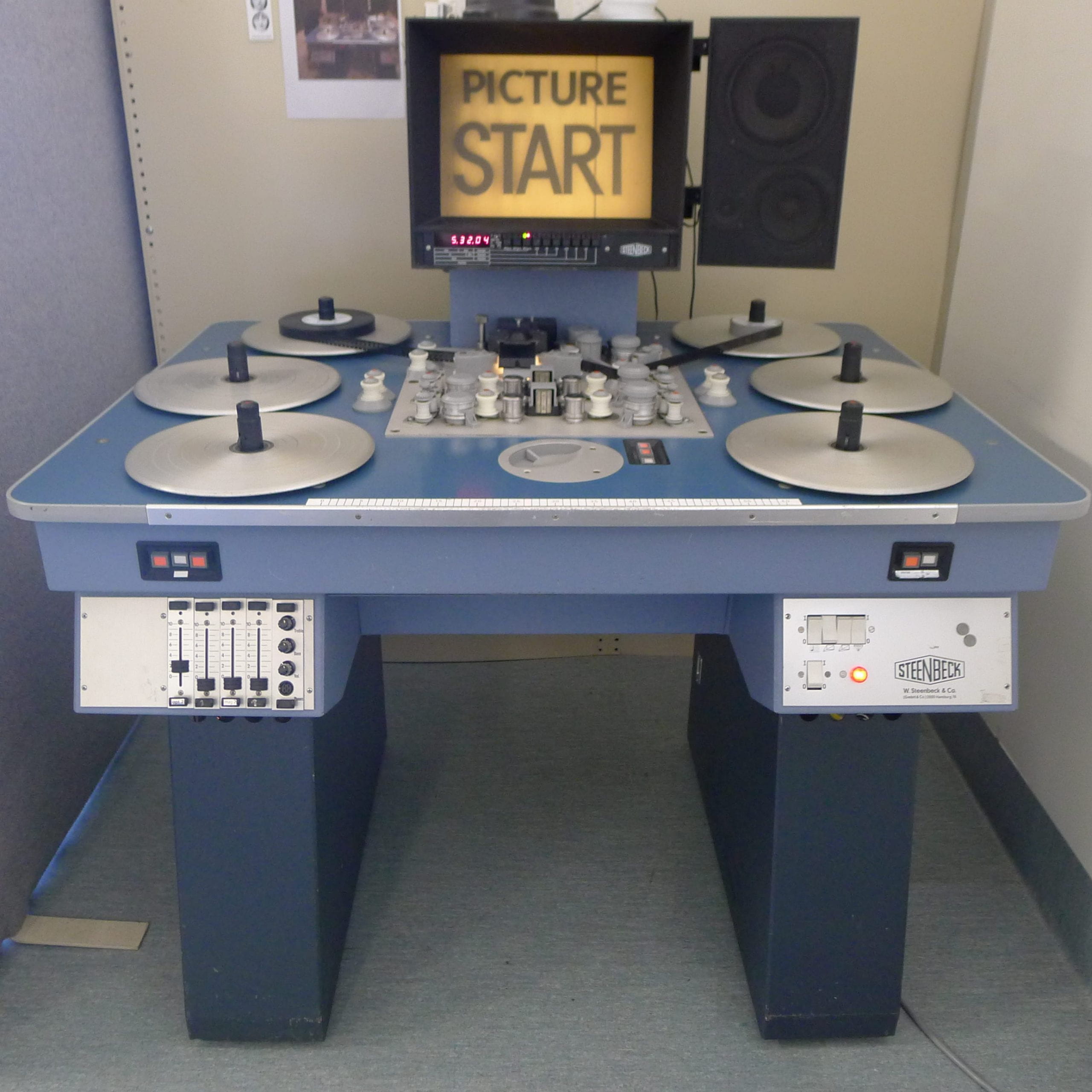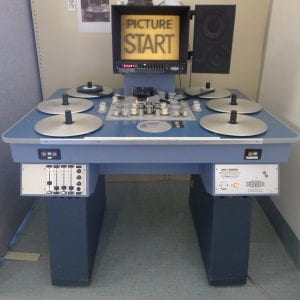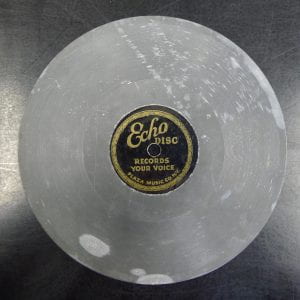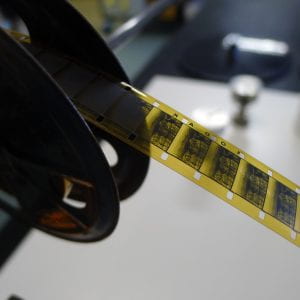
Audiovisual collections at University of Melbourne Archives
Emma Hyde

Emma Hyde began working at the University of Melbourne Archives (UMA) in 2012 as the Audiovisual Archivist in a project supported by the Miegunyah Fund to appraise UMA’s vast and uncatalogued audiovisual material. As the project is nearing completion, Emma is also heading off on maternity leave and we want to take the opportunity to wish her the best of luck and thank her for her work. Her knowledge of audiovisual archiving, her enthusiasm for the collection and fortitude in the face of a seemingly ever-expanding project scope has been of enormous benefit to UMA and her colleagues.
University of Melbourne Archives audiovisual collection is a rich resource spanning over 50 years of collecting and represents many of UMA’s core collecting strengths. The collection, amounting to over 11,000 physical items, contains both professional and amateur content, produced on over 30 AV formats (film, magnetic, acoustic and optical media). UMA’s holdings are testament to rapidly changing audiovisual technologies across the 19th, 20th and 21st centuries. Highlights of the collection include the 35mm film fragments ‘Horseshoeing’ (1893) & ‘Eugen Sandow’ (1894) belonging to Thomas Edison’s assistant, W. K. Laurie Dickson, which is almost certainly the earliest examples of moving image technology known to exist in Australia. Other treasures are an early zinc-coated ‘Echo Disc’ voice recording of Alfred P. Derham (c.1916), home movie footage from Jimmy Watson and Sir Laurence Hartnett (1920s–40s); 16mm release prints and outtakes from the Repco Ltd & CRA Ltd (Rio Tinto) collections (1950s–80s); and U-matic video recordings of staff training from Fletcher Jones & Staff Pty Ltd. (1970–80s). UMA also holds many items from the University’s own film & video production unit, first known as the Audiovisual Aids Department in the late 1940s to its current incarnation as the Video & Media Production Unit with Learning Environments.
A major strength of UMA’s audiovisual collection is audio material, with close to 7,000 items produced on cassette tape, 1/4” Reel to Reel and a smaller number of acoustic disc recordings. Many of these items are unique and represent university life and activities, such as a series of interviews with prominent university staff from the History of the University Unit and the University Assembly recordings of elected staff and students at meetings and workshops spanning 15 years of campus life. Other notable areas of the collection represent feminist and peace movement activities (Alma Morton, Sam Goldbloom and Peace Movement Workshop collections) and many oral history collections which record the experiences of individuals, their social and working lives (Papua New Guinea Patrol Officers interviews, Thirty Seven Women oral history project; and employees of the Shell Company of Australia, Repco LTD and Rio Tinto subsidiaries). The collection continues to grow, with recent acquisitions in the Germaine Greer collection (which includes audiovisual material: audio travel diaries and home movie footage produced by Greer; and recordings of Greer’s TV & radio appearances) and a set of audio tapes produced by journalist Paul Ormonde for his research into the life of Labor politician Jim Cairns.

Zinc ‘Echo Disc’ Voice Recording, showing evidence of zinc corrosion, probably early 1920s
Alfred Plumley Derham collection, 1963.0024
Project work on the audiovisual collections- from auditing to digital access
The above findings were aided with the generous support of the Miegunyah Fund to assist with a long overdue assessment and appraisal of UMA’s audiovisual collection by an Audiovisual Archivist. Project work on the audiovisual material began in 2012 with an audit to assess the size, condition and research significance of the collection. The major objectives of the project were identified as: determining audiovisual materials most at risk, either from fragility or the risk of obsolescence from playback equipment; and conducting preservation work on items or improving storage. During the early stages of the audit it became evident the size and scale of collection and the range of formats held at UMA was greater than first thought. Lack of documentation for AV items and the limited availability of serviced in-house playback equipment to evaluate significance of items made assessments in many cases inconclusive, with further research needed. Initial estimates of between 1500 to 6000 AV items quickly rose to over 11,000, as AV items were discovered in the repository, along with the acquisition of more AV collections during the audit.
An extensive AV database was developed to capture metadata documenting location, provenance, titles/descriptions, technical details and condition reporting of AV at item level. A standard terminology (based on National Film & Sound Archive and National Archives of Australia descriptions) was developed for the identification and technical descriptions of the material. The AV database expanded to become an essential tool for scoping a preservation and digitisation schedule for the collection.
UMA’s audit revealed a comprehensive picture of its audiovisual collection and findings identified where high priority AV collections exist in terms of research value, uniqueness and fragility/obsolescence. On a broader level this project work highlighted the immediate need to secure appropriate environmental controls to ensure the long term preservation of physical AV material. Running in tandem with analogue preservation is UMA’s development of digitisation projects to salvage valuable content from formats at risk of obsolescence and through digital preservation provide access to researchers in the future. The information collected during the AV audit has given UMA a good working foundation to build digital preservation strategies for its AV collection and taking small, if not significant steps, to ensure future access to unique material. The current focus of the project has now shifted from auditing the collection to writing guidelines and processes for AV appraisal, handling, long term preservation requirements and digital preservation workflows. Over the past year project work has involved working with external vendors on a series of small pilot projects to digitise AV collections and help promote interest in UMA’s AV collection. UMA’s small collection of 9.5mm films of Jimmy Watson’s home movies were digitised by Deluxe Film labs in South Melbourne and a larger project to digitise over 70 U-matic video tape recordings from the Fletcher Jones collection was carried out by DAMSmart in Canberra using their SAMMA Solo video migration system. The AV project is a timely response to the many challenges facing the future of audiovisual preservation and access in the digital age.

William Glanville Lau Cook collection, 1984.0077
Over the last number of years it has become increasingly apparent that audiovisual material is as equally significant, complementary and integral to UMA as its wider paper collections. UMA is in the process of cementing audiovisual archiving principles and terminology into the everyday work of the archive, by integrating metadata in UMA’s collection management system and incorporating AV digitisation workflows within the university’s wider Digital Preservation Strategy. With continued work on the AV project UMA is securing the long term preservation of its physical AV collection and conducting essential digital preservation work, ensuring these fascinating audiovisual recordings are made accessible to researchers in the years ahead.
Categories
Leave a Reply